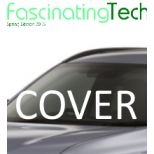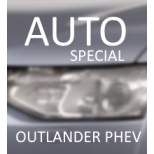FascinatingCars - Mitsubishi Outlander PHEV review - Fascinating Tech Magazine Archivee
Main menu:
FascinatingCars - Mitsubishi Outlander PHEV review
Archived Issues > Spring 2015

When people think of SUV's they often have the view of the Chelsea Tractor guzzling up petrol as it does the school run. Yes there are some advantages to an SUV in visibility, space and safety but for a lot of people these are totally offset by the high fuel consumption with even modern vehicles averaging less than 30 MPG in urban driving
What if we were to tell you that a few weeks back we were driving around town in a sizeable 4x4 and getting over 85MPG. What if we were to further tell you that this vehicle is exempt from Car Duty, can be driven into the London Congestion charge area without cost (you do have to register first) and is in the 5% Benefit in kind(BIK) category for Company Car Tax.
What kind of miracle vehicle is this? Well its the first of its kind Mitsubishi Outlander PHEV - Plug In Hybrid Electric Vehicle. This is a 4x4 where the complex drive train has been replaced with a pair of electric motors one driving the front wheels, the other the rear. These run off charge contained in a battery strapped to the underside. Unlike many electric vehicles a where load space and handling are compromised by the addition of a battery there is minimal compromise with the Outlander. The boot space is nearly identical to its Diesel based equivalent in the range and handling seems enhanced by the low centre of gravity. The battery charge which lasts around 20 to 30 miles depending on temperature, driving style and speed, is supplemented by a 2 Litre petrol engine. This kicks in when charge is getting low and is used to power the Electric motors and charge the battery. If a little extra oomph is needed the petrol engine has a clutch to attach itself to the front wheels and power them directly. These three modes are known as pure electric, Serial Hybrid and Parallel Hybrid respectively.
PREVIEW VIDED -NOT COMPLETE
PREVIEW VIDED -NOT COMPLETE
Updated 29th May - More video to follow
An overnight charge costs between 50 pence and 1 pound 20 depending on your Tariff and the car is supplied with a lead to charge from a 3 pin plug. There are also currently incentives to allow you to have a dedicated charging plug installed at home which can speed up the charging process. To be honest the 13 pin is good enough as charging takes around 6 to 7 hours. It is however a shame that a Class 2 to Class 1 charging cable is not supplied as this is what many of the Public Chargers use – particularly the council supplied ones. There is however a Chademo Fast Charger port which allows you to use the Ecotricity range of fast chargers at Service Stations on the motorways – these already have a cable connected. This charges using DC power and can charge to 80% in the time it takes to have a cup of coffee – giving around 18 to 25 miles extra charge depending on conditions. You can also get some charge back through regenerative braking. That is a bit like the KERS system used on Formula One cars – as you break the flow of energy is reversed with the Electric Motor supplying braking and acting as a generator to charge the battery. This can be highly effective adding tens of miles of electric power to a journey.
If your daily journey is less than 20 miles and you drive in urban roads with minimal Motorway driving you may well never need to use petrol - getting infinite MPG. Start driving at 70MPH and above and your MPG will go down. Once the charge has run out you might get around 30MPG (but remember this will be offset by the near infinite MPG on your Electric part of the journey). If you are doing longer commutes there comes a point at around 120 Miles average journey that the Diesel is actually more economical.
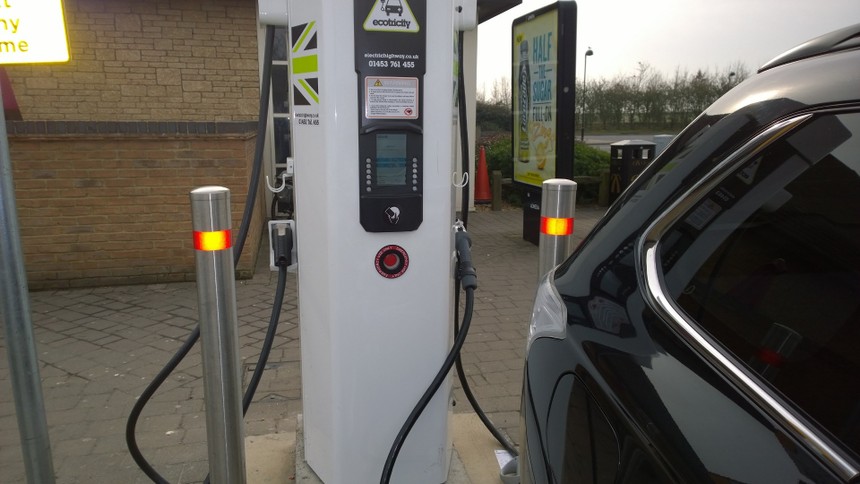
Mitsubishi are a bit ham-strung when it comes to quoting MPG they have to quote the official figures but these are very advantages to EVs (Electric Vehicles) and give a false impression if you do more than a few miles a day. The only way you will get the headline figure, and above, is if the vast majority of your journey is on Electric Power - which for the School run might be perfectly feasible. One foible of the systems on the Outlander are that the MPG guage only has 2 digits so even though it is capable of economy of over 100MPG it can't display it showing "--" instead. The other annoyance on gauges are that both the expected electric and petrol ranges are just guesses based on your previous driving styles and not very good ones. We often got a lot more range than suggested. The real annoyance is when they get to single digit ranges they will suddenly cut out and show just -- which is really helpful when you are trying to work out if you have enough juice to get to the next service station or charger. Mitsubishi are aware that these 'Guess Meters' are a source of annoyance to owners so we would expect this to change on a future model. It is not the end of the world and as we used so little petrol over our week with this car - despite doing quite a few long journeys - we never got close to running out.
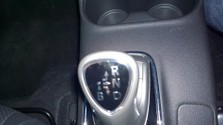 The good thing is it is extremely pleasant to drive, well equipped and comfortable. The lack of vibration from the petrol engine reaching you through the steering wheel is novel and relaxing. This is a very different but exceptionally good driving experience. It handles really well due to the low centre of gravity - none of the wallow we often associate with a 4x4. Indeed it cornered very similarly to a Mercedes SLK driven by one of our reviewers. It doesn't quite have SLK grunt but combine Electric and Petrol and it gets going plenty fast enough. The tremendous torque of the Electric Motors mean there is no need for gears. The gear box is really just a selection for forward or backwards. It does have an additional mode which switches up regenerative braking. This can aso be varied by the Flappy Paddles behind the steering wheel - a nice touch - allowing you to vary the strength of the regen from bringing you to a complete stop when you lift the accelator to allowing you to coast. One thing to note in the strongst setting is that the brake lights don't come on when you lift your foot but you could be braking as fast as some conventional vehicles do when pressing the brakes. We did notice that the brakes did appear to give some regen on the first part of travel and indeed did not seemt to engage the mechanical brakes - this may turn out to be yet another cost saving with brake pads taking on less wear. Indeed generally there are a lot less mechanical parts to service.
The good thing is it is extremely pleasant to drive, well equipped and comfortable. The lack of vibration from the petrol engine reaching you through the steering wheel is novel and relaxing. This is a very different but exceptionally good driving experience. It handles really well due to the low centre of gravity - none of the wallow we often associate with a 4x4. Indeed it cornered very similarly to a Mercedes SLK driven by one of our reviewers. It doesn't quite have SLK grunt but combine Electric and Petrol and it gets going plenty fast enough. The tremendous torque of the Electric Motors mean there is no need for gears. The gear box is really just a selection for forward or backwards. It does have an additional mode which switches up regenerative braking. This can aso be varied by the Flappy Paddles behind the steering wheel - a nice touch - allowing you to vary the strength of the regen from bringing you to a complete stop when you lift the accelator to allowing you to coast. One thing to note in the strongst setting is that the brake lights don't come on when you lift your foot but you could be braking as fast as some conventional vehicles do when pressing the brakes. We did notice that the brakes did appear to give some regen on the first part of travel and indeed did not seemt to engage the mechanical brakes - this may turn out to be yet another cost saving with brake pads taking on less wear. Indeed generally there are a lot less mechanical parts to service.Our GX4HS model came with additonal safety equipment including Lane Departure Warning, Adaptive Cruise control and Forward Collision Mitigation. These are only available on model numbers ending in the letter S.
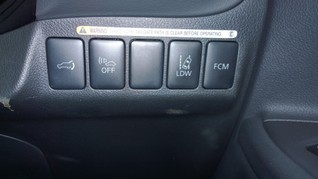
The Lane Departure Warning system uses cameras to monitor the road ahead for lane markings and beeps at you if you stray outside the lines whilst not indicating. This beep can get very annoying on tight rural roads but is perfectly acceptable and useful on long, boring, motorway runs where attention may wander. You can turn off the warning by pressing a button. As with couple of other buttons this is badly placed being obsured form the driver's vision by the steering wheel. It also defaults back to on whenever you turn the car on and off.
In some ways we can see where this is a better system than the systems that vibrate the steering wheel when you depart a lane as it will definitely wake you up.
The adaptive cruise control allows you to choose a speed and then attempts to maintain that speed whilst using radar to keep a safe distance from the vehicle ahead. This worked really on motorways, even in queuing traffic where it was a real pleasure. It was less effective when approaching roundabouts where it could scarilly start accelerating towards the roundabout as the car in front pulled out of the way - to be fair Mitsubishi warn againstthis and its pretty clear you shouldn't be using it in this manner. One really nice thing is that you can set how much distance you want to maintain from the vehicle in front with discrete settings.
We really liked the Forward Collision Mitigation - this should be standard on all cars. What it does is to monitor if you are approaching a Vehicle in front too quickly - or in our case if a vehicle suddenly pull out in front of you - and initially warns you whilst preloading the braking system so it is more responsive, if you still don't respond to the situation it will brake for you. It cannot be guaranteed to avoid all accidents and you should definitely remain in control but it certainly can help.
We also like the Reversing Camera which comes standard on all GX4H models and above. Initially we were a little disappointed that the overlay only had fixed lines, showing the width and length of the car,and did not have lines showing the path the wheels would take. We soon learnt though that these fixed lines work really well. The stroke of genius is having a line marking where to stop and still get the boot open. We also found this horizontal line invaluable in determining if we were lining up straight on a space. In many ways this was actually less confusing than the lines on other vehicles that show the directional path. One real bugbear with this camera is although the rear camera view appears immediately you power on and put the car in reverse, the overlay only appears once the MultiMedia Control System (MMCS) boots up. This can take minutes and is not acceptable in a modern vehicle.
Once it has booted the MMCS (standard on GX4H and above) is pretty good, a lot better than we were expecting from comments we had seen elsewhere. The screen is very clear with a decent definition. Controls can be confusing with a mix of offscreen and onscreen buttons which can be very unintuitive. However the radio is good eith both DAB and analogue. DAB is particularly good locking onto signals which we couldn't get on other systems - although it did seem to have an issue retaining the names of stations. You can also play CDs, Bluetooth Audio and plug in a USB device. Bluetooth Audio, once through a particularly clunky pairing process, was really good. Overall whilst perhaps lacking a bit of base Audio quality was also very good. The navigation system is actually better than a lot of other vehicles and we particularly like full PostCode support although we couldn't understand why we were always forced to enter a street name as well - sometimes you only know the Post Code. Fortunately there was a choice of streets. One thing that some owners moan about is the voice used for navigation which is a little overbearing at times - you don't want to disobey her.
Another nice thing on the Sat Nav is the way upcoming turns are shown in the dashboard console with a very clear countdown to the junction. We found this to be one of the best indications of which junction to take we have ever used.
The driver's dashboard console shows a lot of information with a speedo on the right, an info panel in the middle and an conomy meter on the left. This latter shows whether you are using power, putting it back into the battery with regen or hitting the red and using petrol. In practice this is very easy to get on with and there is a joy in keeping it in the green.
The center info panel is where you find battery charge and petrol level indicators and an information display that can tell you things like mileage, trip mileage, Miles remaining on charge and petrol. This latter is what we mentioned before is known as the 'Guess Meter' by some drivers as that is basically what it does - guessing how many miles your petrol or charge will last depending on your driving style and predicted road conditions. From our experince it often underestimates - I guess playing safe. Battery range can be affected by other factors particularly heat - if you buy this car in the summer you are going to be disappointed in the drop of miles in the winter. Having said that the reverse is true and you might see the extra miles as a summer bonus.
Returning to the info panel the content of the display is controlled by another annoyingly positioned button. This is on the right and side of the console hidden behind the steering wheel. This should be visible as it is a button you will want to use whilst driving. It would be far better if this was actually on the steering wheel. Having said that navigation of this system is straight forward and pretty intuitive. Although the Auto and Manual Trip meters can be confusing. Auto resets the trip when you stop the motor for a time whilst manual is controlled well manually but the manual is not very clear on how to do this. We recommend visiting the independently run Phev Club and reading their forum for info on this and a lot of other useful info.
One thing we noticed over our week of driving the Outlander was that our passenger always seemed entertained with the myriad of information you can get on the MMCS about how the car is driving. which mode it is in and how much charge is being used. We were initially worried how distracting this information might be for a driver but after a couple of days you soon totally ignore this and use just the main console. It is fun and useful information though and our passenger really missed it when we had to return the vehicle.
Overall whether this vehicle is for you will depend on your lifestyle and particularly whether you are a company car driver where the low BIK rate can make this vehicle exceptionally economical. What we can say is we didn't want to give the vehicle back and would seriously consider buying one next time we are in the market.
